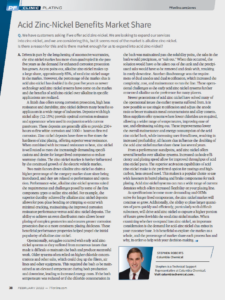Technical & Safety Data
Log in or sign up to access technical data, safety data, applicator approvals and troubleshooting guides.

Products Finishing
Expert Clinic/Plating
Stephen Roberts, Technical Support Representative ~ Columbia Chemical
Q. We have customers asking if we offer acid zinc nickel. We are looking to expand our services into zinc nickel, and we are considering this, but it seems most of the market is alkaline zinc nickel. Is there a reason for this and is there a market enough for us to expand into acid zinc-nickel?
This is a good question to ask as you consider expanding your services to include zinc nickel. Driven in part by the lengthening of automotive warranties, the zinc-nickel market has more than quadrupled in the past five years as the demand for enhanced corrosion protection has grown. As you point out, alkaline zinc-nickel makes up a large share, approximately 85%, of total zinc-nickel usage in the market. However, the percentage of the market that is acid zinc-nickel has doubled in the past five years as newer technology acid zinc-nickel systems have come on the market and the benefits of acid zinc-nickel over alkaline in specific applications are realized.
A finish that offers strong corrosion protection, high heat resistance, and durability, zinc-nickel delivers many benefits to applicators in a wide range of industries. Deposits with high nickel alloy (12-15%) provide optimal corrosion resistance and appearance when used in conjunction with current passivates. These deposits are generally able to provide 250+ hours to first white corrosion and 1000+ hours to first red corrosion. Zinc nickel deposits have three to five times the hardness of zinc plating, offering superior wear resistance. When combined with increased resistance to heat, zinc-nickel is well suited to meet the increasingly demanding specifications and desire for longer-lived components to reduce warranty claims. The zinc-nickel market is further influenced by the continued growth of the electric vehicle market due to its extended vehicle life cycle.
Two main factors drove alkaline zinc-nickel to claim a higher percentage of the category market share since being introduced, and they are related to performance and operation. Performance-wise, alkaline zinc-nickel systems suited the requirements and challenges posed by some of the first component types to utilize zinc nickel. For example, the superior ductility achieved by alkaline zinc-nickel deposits allows for post-plate bending or crimping to occur with minimal cracking, maintaining the improved corrosion resistance performance versus acid zinc-nickel deposits. The ability to achieve an even distribution ratio allows better plating of complex geometries and ensures greater corrosion protection due to a more consistent plating thickness. These beneficial performance properties helped propel the initial popularity of alkaline zinc nickel.
Operationally, struggles occurred with early acid zinc nickel systems as they suffered from numerous issues that made it difficult to maintain the bath and produce successful work. Older systems often relied on higher chloride concentrations and other salts, which could clog up the filters, air lines and other equipment. This required the bath to be maintained at an elevated temperature during both production and downtime, leading to increased energy costs. If the bath temperature was reduced or if the chloride concentration in the bath was maintained past the solubility point, the salts in the bath would precipitate, or “salt out.” When this occurred, the solution would have to be taken out of the tank and the precipitated salts would have to be removed and dealt with, resulting in costly downtime. Another disadvantage was the requirement of dual anodes and dual rectification, which increased the complexity, cost, and maintenance to run the line. These operational challenges to the early acid zinc-nickel systems further cemented alkaline as the preference for many platers.
Due to technological advances, newer generations of acid zinc nickel have solved many of the operational issues the earlier systems suffered from. It is now possible to use single rectification and adjust the anode ratio to better maintain metal concentrations and alloy content. Most suppliers offer systems where lower chlorides are required, allowing a wider range of temperatures, improving ease of use, and eliminating salting out. These improvements lower the overall maintenance and energy consumption of the acid zinc nickel bath, while increasing user-friendliness, resulting in increased profitability, all factors that influence the doubling of the acid-zinc nickel market share these last several years.
To recap, as specifications become more demanding and OEMs strive for longer-lived components, the zinc nickel market will continue its overall rapid growth. Additionally, the ability to plate larger quantities of parts quickly and efficiently, particularly with difficult substrates, will drive acid zinc nickel to capture a higher portion of future growth within the total zinc nickel market. When examining whether to expand into zinc nickel, an important consideration for you is the demand for acid-zinc nickel that exists in your customer base. It is beneficial, however, to ask these questions, explore the zinc nickel market as a whole, and the percentage of market share each process has and why, in order to help with your decision-making.